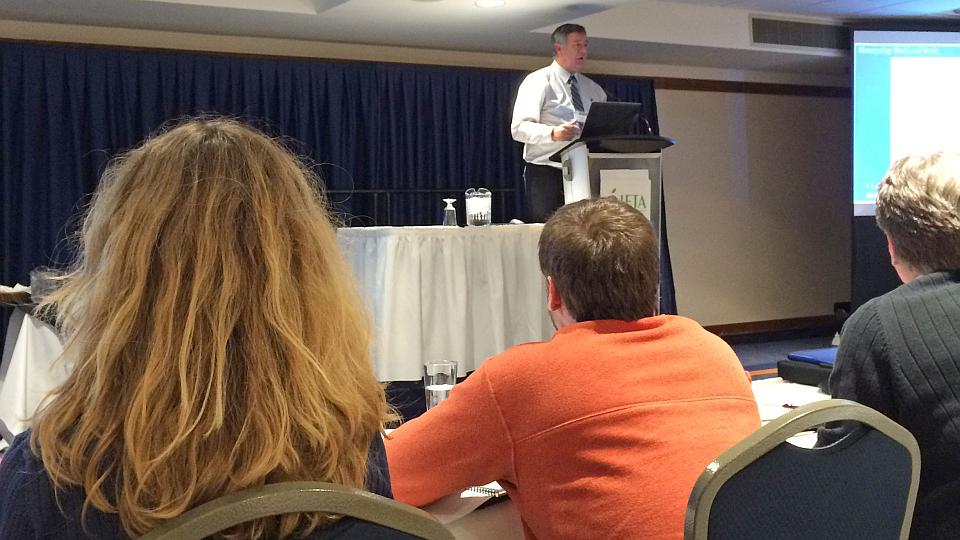On The Road With IFTA: Conference Day 1

“It’s a pressure-packed job. Once I make the first cut, people say ‘I can do better than Robinson. He just threw out a bushel of apples,’” Terence Robinson says of growers at educational tours. (Photo credit: Christina Herrick)
There’s a delicate balance between growing a quality Honeycrisp and being profitable. It’s a variety as well known for its growing challenges as it is for its distinct crunch and flavor.
So, it was no surprise that when the International Fruit Tree Association (IFTA) decided to focus entirely on Honeycrisp for its preconference workshop in conjunction with the 58th Annual IFTA Conference, interest was great, to say the least.
Although there were a wide-range of topics under the Honeycrisp umbrella, each presenter stressed the need for proper crop load management in order to ensure that each Honeycrisp in consumers’ hands is the best quality experience possible.
The trouble with Honeycrisp is growers are seeking those first-to-the-market dollars. That often leads to overcropping. It’s an easy thing to do, especially when short term returns are high, but it’s not necessarily the best strategy for offering a type of apple that will create a return buyer.
Bruce Allen of Chiawana Orchards LLC., says quite simply “Over-cropping of Honeycrisp will give consumers a bad piece of fruit.”
Allison DeMarree of Cornell University discussed the economics of Honeycrisp. She says growers need to understand what their 10-year return on investment would be.
“Most other apple varieties, you’re waiting 12-15 years for return on investment, but with Honeycrisp, it is so finicky and there are added costs, you need to be shooting for high dollars,” she says.
However, DeMarree notes there is a balance growers must make in order to ensure top-dollar trends for Honeycrisp continue.
“If the average consumer buys an apple and there are problems they may not buy it again,” she says. “If you’re not improving your fruit quality, you are at a higher risk”
Jim Engelsma of J. Engelsma Orhcards in Michigan took a different approach when it came to growing Honeycrisp. Instead of rushing to get his trees into production, he focused entirely on allowing his trees to grow and fill the canopy. This, he said, provides him a chance to get a consistent high-quality yield.
The packouts on his Gala have been as high as 97% and as low as 92%. For Honeycrisp, the highest was 94% and the lowest was 88%.
“If we grow good Honeycrisp and we learn how to keep Honeycrisp, we’re off to a good start,” Engelsma says.
Despite what many growers think, Hank Markgraf, grower services manager for BC Tree Fruits cooperative, says, “You will not make more money with more apples on the tree. Grow trees first, grow your crops second.”
Balance is crtitcal, says Lailang Cheng of Cornell University. Low crop load will create higher incidence of bitter pit. Heavy cropping apples will have poor taste and color.
In order to prevent bitter pit, Cheng encourages growers in the East to apply 3 pounds of elemental calcium per acre per year.
“As fruit size increases, fruit calcium levels decrease,” he says.
Terence Robinson of Cornell University says crop load management is “an effort to control crop load to a specific target. An ideal target helps.”
Echoing what many speakers indicated, the crop load of Honeycrisp directly impacts taste, quality, and storage disorders.
Robinson encourages growers not to have too high of a fruitset on young Honeycrisp trees. He acknowledges, though, that Honeycrisp is a variety that likes to set a lot of buds.
“In second and third year if you hang too many fruit on an early tree, you don’t get the return bloom,” he says. “This variety is too valuable, you have to get out and hand thin.
Two Quick Notes From Today’s Sessions
At last year’s IFTA conference, Bruce Allen said 100 bins to the acre was something all growers should be trying to strive for. This year, he said he’s aiming for more in the 120-130 bins to the acre. Just in case any of you thought you were getting close to his production numbers.
Terence Robinson of Cornell University began his presentation by saying how much he enjoys catching up with familiar faces and meeting IFTA members from around the globe. Robinson is taking a three-year sabbatical from Cornell and introduced Poliana Francescatto and Jaume Lordan Sanahuja, who will be continuing his research.
More Updates
For more from IFTA, be sure to check out Christina Herrick’s Twitter feed @HerrickAFG, where she will be sending updates from all the sessions and catch the April issue of American Fruit Grower magazine for a recap of the conference.










